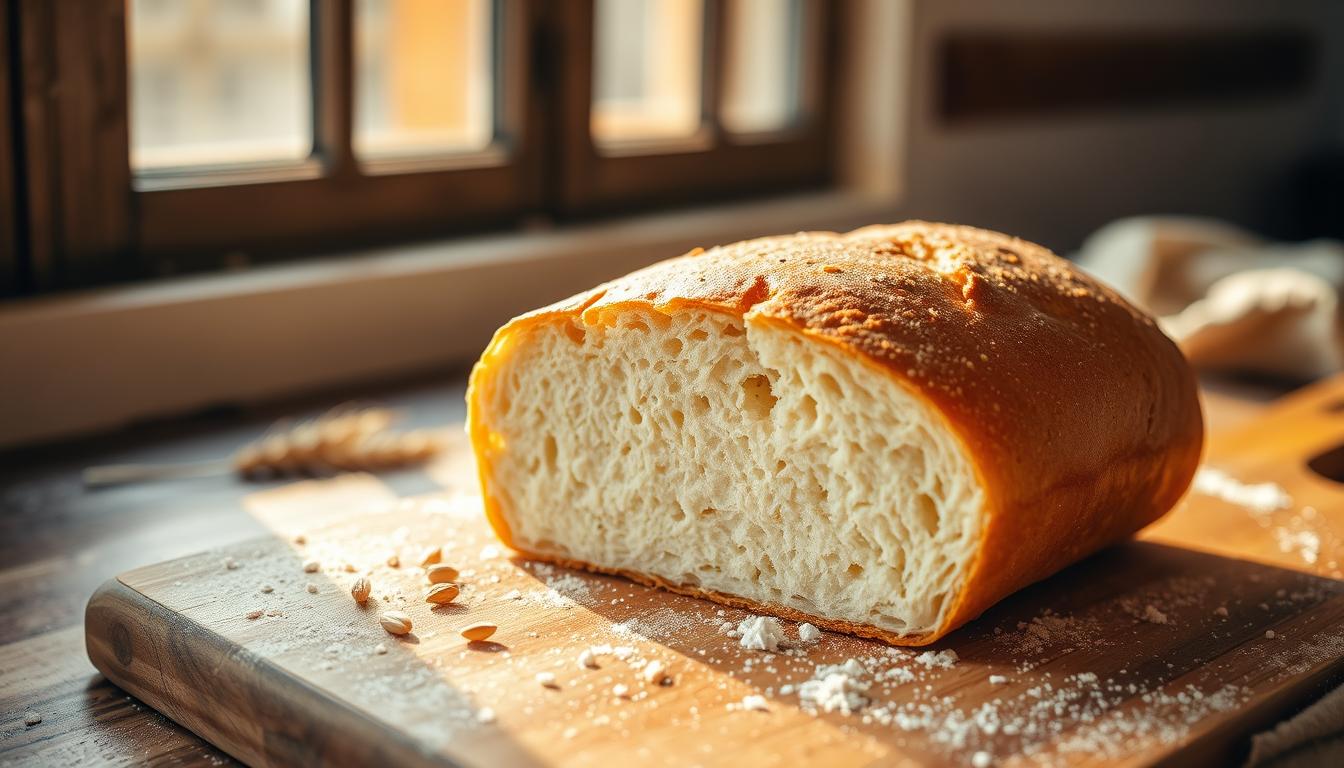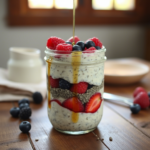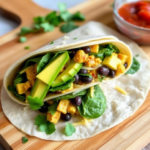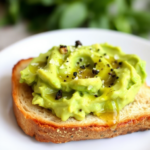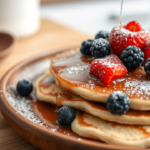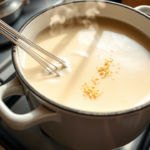The smell of fresh bread in your kitchen is amazing. The softness and crunch of the crust are a treat for your senses. Sandwich bread offers endless options, from classic white to hearty whole wheat.
This guide will teach you how to make your own sandwich bread. With a few simple ingredients and patience, you can make a loaf as good as any bakery. It doesn’t matter if you’re new to baking or experienced. You’ll find easy steps and tips to help you succeed.
Table of Contents
Understanding Different Types of Sandwich Bread
Choosing the right bread for your sandwiches can really make a difference. From classic white to whole wheat and multigrain, each has its own taste and texture. Let’s dive into the world of sandwich bread and find the perfect match for your meals.
Traditional White Sandwich Bread
White sandwich bread is a favorite in many homes. Its softness and mild taste make it great for many sandwiches. It’s also good at letting other flavors stand out.
Whole Wheat and Multigrain Options
Looking for something healthier? Whole wheat and multigrain breads are great alternatives. They’re packed with more fiber and nutrients than white bread. Their rich flavors go well with turkey, avocado, or hummus.
Artisan vs. Everyday Sandwich Bread
There’s a big difference between artisan and everyday sandwich bread. Artisan breads, like ciabatta and sourdough, are made with care and have unique tastes. They’re perfect for paninis. Everyday breads, however, are made to be consistent and affordable for busy families.
| Bread Type | Characteristics | Ideal for |
|---|---|---|
| White Bread | Soft, fluffy texture, mild flavor | Grilled cheese, PB&J |
| Whole Wheat Bread | Hearty, nutty flavor, more nutrients | Turkey, avocado, hummus |
| Multigrain Bread | Blend of grains, textured, flavorful | Variety of fillings |
| Artisan Bread | Crisp crust, chewy interior, unique flavors | Paninis, specialty sandwiches |
| Everyday Bread | Consistent, affordable, mass-produced | Basic sandwiches |
Knowing the differences between bread types helps you pick the best one for your sandwiches. This way, you can enjoy a great meal every time.
Essential Ingredients for Making Sandwich Bread
To make the perfect sandwich bread, you need a few key ingredients. Bread flour is the base, giving your loaf its structure and chewiness. Yeast makes the dough rise and gives it an airy texture. Honey or sugar add sweetness, balancing the flavors.
Butter or milk make the bread rich and soft. To get the yeast working, you need warm water or milk, around 85-90°F. This temperature is perfect for yeast to bloom and start the rising process.
The classic ratio for bread making is 5 parts flour to 3 parts water. The recipe in the text uses almost 300 grams of water for 500 grams of flour. This is a bit more water than usual, thanks to the added fat.
| Ingredient | Purpose |
|---|---|
| Bread Flour | Provides structure and chewiness |
| Yeast | Responsible for rising and airy texture |
| Honey or Sugar | Natural sweeteners that balance flavors |
| Butter or Milk | Adds richness and a soft, tender crumb |
| Warm Water or Milk | Activates the yeast |
Knowing how each ingredient works is crucial for making great sandwich bread. With the right mix of bread flour, yeast, honey, butter, and milk, you’ll soon be a pro at baking.
Required Equipment and Tools
Making delicious sandwich bread at home needs a few key tools. You’ll need a stand mixer with a dough hook and a loaf pan. Each tool is important for getting the right texture and crust. Let’s look at the essential items for your bread-making adventure.
Mixing and Kneading Equipment
A stand mixer with a dough hook makes mixing and kneading easy. The Kenwood 5-Quart Chef Titanium Kitchen Machine is a top pick for $560. It’s perfect for those who want to avoid manual work. For a more hands-on experience, try the Original Danish Dough Whisk for about $14. It has a wooden grip.
Baking Pans and Measuring Tools
The USA Pan Nonstick Standard Bread Loaf Pan is great for baking loaves for $21. Use it with measuring cups and a digital thermometer. They help you measure ingredients right and set the perfect baking temperature.
Optional Accessories
Some accessories can make bread-making better. Think about getting a Cambro Camsquare Food Container for $19. It’s good for measuring and proofing dough. An OXO Bench Scraper for $12 is useful for many tasks. Proofing baskets, like the Bread Banneton Proofing Basket and Lame Set for $50, help keep your loaves’ shape.
Choosing the right tools is key to making perfect homemade sandwich bread. Invest in quality gear that fits your baking style. Enjoy making delicious, fresh bread in your kitchen.
The Science Behind Perfect Sandwich Bread
Making the perfect sandwich bread is more than just a recipe. It’s about knowing the science of ingredients and baking. Every step, from gluten development to yeast fermentation, affects the bread’s texture, taste, and quality.
The balance between flour and water is key. The recipe suggests using 5 1/2 – 6 1/2 cups of all-purpose flour. The dough’s consistency is also crucial. You might need to adjust the liquid-to-flour ratio if it’s too sticky or dry.
The type of yeast used can change the bread’s outcome. This article compares active dry yeast and instant yeast. Yeast fermentation is important for gluten development and bread chemistry.
Ingredients aren’t the only thing that matters. Mixing and kneading techniques are also vital. Proper gluten development comes from thorough mixing and kneading. This ensures the dough rises and bakes into a beautiful loaf.
“The key to perfect sandwich bread lies in understanding the delicate balance of ingredients and the science behind the baking process.”
By mastering sandwich bread making, you’ll create a loaf that’s visually appealing and delicious. With some knowledge and practice, you’ll bake exceptional homemade bread.
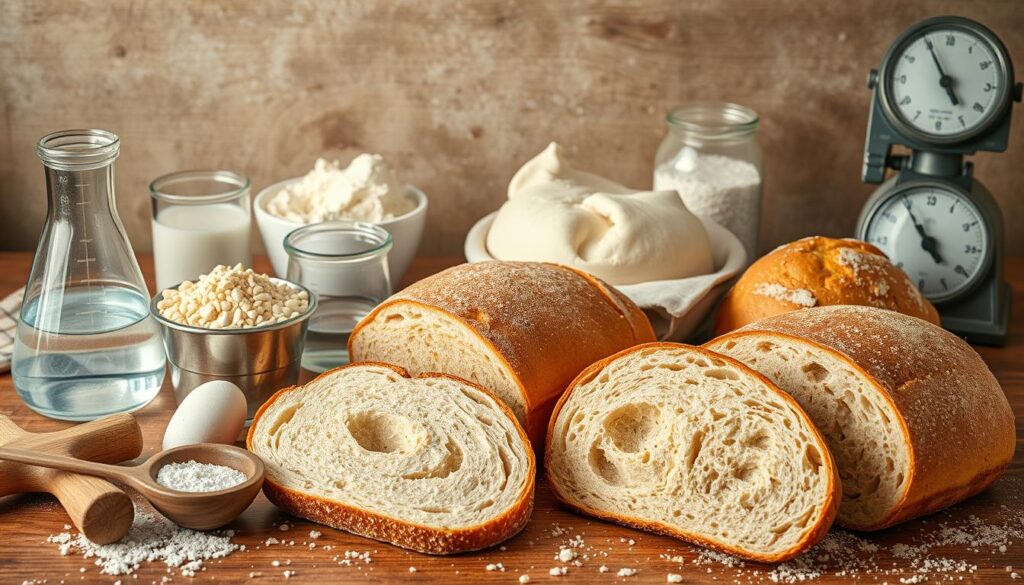
Step-by-Step Mixing and Kneading Process
Making the perfect sandwich bread begins with mixing and kneading. You can use a stand mixer or knead by hand. Knowing the steps helps your dough get the right texture and gluten.
Proper Mixing Techniques
Start by proofing the yeast in warm water. Let it get foamy and active. Then, mix dry ingredients like flour, salt, and seasonings in a big bowl.
Slowly add the wet ingredients, including the yeast mixture and olive oil. Keep mixing until you get a shaggy dough.
Kneading Methods for Best Results
Kneading is key to developing the dough’s gluten. You can knead by hand or with a stand mixer. Hand-kneading takes 8-10 minutes, while a stand mixer does it in 3-5 minutes.
Knead until the dough is smooth, elastic, and can pass the windowpane test. This means you can stretch a small piece of dough thin without it tearing.
Visual Cues for Perfect Dough
Watch for these signs as you knead:
- The dough should be smooth, soft, and slightly tacky.
- It should pass the windowpane test, showing a thin, translucent “windowpane” effect.
- The dough should hold its shape well and spring back when poked.
Mastering mixing and kneading is crucial for a great sandwich bread. It ensures your bread rises well, is tender, and tastes amazing.
Rising and Proofing Techniques
Learning how to proof dough is key to making great sandwich bread. It’s all about the science of yeast and how dough rises. Let’s dive into the techniques to make your dough perfect.
To proof dough well, keep it warm, between 75°F to 100°F. This warmth helps yeast work, making the dough grow. A draft-free, humid spot is best for proofing.
The first rise, or “bulk fermentation,” takes 1 to 4 hours. It depends on the dough and the room’s temperature. The dough should double in size. To check, poke it gently with your finger. If it springs back, it’s ready for the next step.
The second rise, or “final proofing,” shapes the loaf. It lasts 1 to 2 hours. This lets the dough grow more and set before baking. Watch it closely to avoid a misshapen loaf.
For deeper flavor, try refrigerating the dough overnight. Proofing it in the fridge for 8 to 16 hours adds complexity. Just don’t leave it too long, or it will lose its shape.
| Proofing Temperature | Proofing Time |
|---|---|
| 80°F (26°C) | 1 to 2 hours |
| 74 to 76°F (23-24°C) | 2 to 4 hours |
| 46°F (8°C) | 6 to 8 hours |
| 39°F (4°C) | 10 to 16 hours |
Mastering dough proofing, yeast activation, and bread rising will help you bake light, fluffy sandwich bread every time.

Shaping Your Sandwich Bread
Making the perfect sandwich bread starts with shaping the dough. This step is key for the bread’s look, texture, and structure. Learning to shape well can give you a smooth crust and a fluffy inside, perfect for sandwiches.
Basic Shaping Methods
The log roll method is a common way to shape sandwich bread. Start by pressing the dough into a rectangle and then roll it into a log. Seal the seam and tuck the ends under for a uniform loaf. This method helps get a smooth crust and even rise.
For a taller loaf, try the envelope fold technique. Pat the dough into a rectangle and fold the top and bottom thirds toward the center. Roll it into a tight log, sealing the seam with your fingers.
Creating the Perfect Loaf Form
To get the right texture and look, pay close attention to shaping. Keep the dough tight and even as you shape it. Don’t overwork the dough, as it can lose its structure and rise.
The type of bread and pan you use also matters. Lighter breads might need a looser shape, while denser breads need a tighter shape.
Try different shaping methods and adjust based on your bread and pan. This way, you can make beautiful sandwich loaves with a great texture and a golden crust.
Baking Temperature and Timing Guidelines
To make the perfect sandwich bread, you need to master baking. Preheat your oven to 350°F (177°C). Then, bake the bread for 30 to 35 minutes. This high heat creates an oven spring and a delightful crust.
For perfectly baked bread, use a digital thermometer like a Thermapen®. Check the bread’s internal temperature. It should be 190°F (88°C) when done. Or, tap the bottom of the bread. If it sounds hollow, it’s ready.
Let the bread cool completely before slicing. This step is key for a soft, tender texture. Once cooled, your homemade sandwich bread is ready to enjoy or store for later.
FAQ
What are the key ingredients for making soft, fluffy sandwich bread at home?
To make perfect sandwich bread, you need flour, water or milk, and yeast. You also need a sweetener like honey or sugar, and fat from butter or oil.
What types of sandwich bread can I make at home?
You can make many types of sandwich bread at home. This includes traditional white, whole wheat, and multigrain. You can also try making artisan-style bread, which has different ingredients and baking methods.
What equipment and tools are needed for making sandwich bread?
You’ll need a stand mixer with a dough hook, large bowls, and loaf pans. Measuring tools are also essential. Optional tools like dough scrapers and proofing baskets can make the process better.
How do I properly knead and shape the sandwich bread dough?
You’ll learn how to mix and knead the dough, by hand or with a mixer. The windowpane test shows when the dough is ready. Shaping the dough into a log is key for the right texture and look.
What’s the science behind creating the perfect sandwich bread?
The science of making great bread involves gluten, yeast, and the right ingredients. The 5:3 flour-to-water ratio and proper kneading and proofing are key. They help develop flavor and structure.
How do I know when my sandwich bread is done baking?
To check if your bread is done, bake it at 350°F for 30-35 minutes. Use an internal temperature of 190°F or the hollow sound method. Cool the bread before slicing to keep it fresh and soft.


